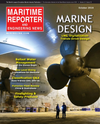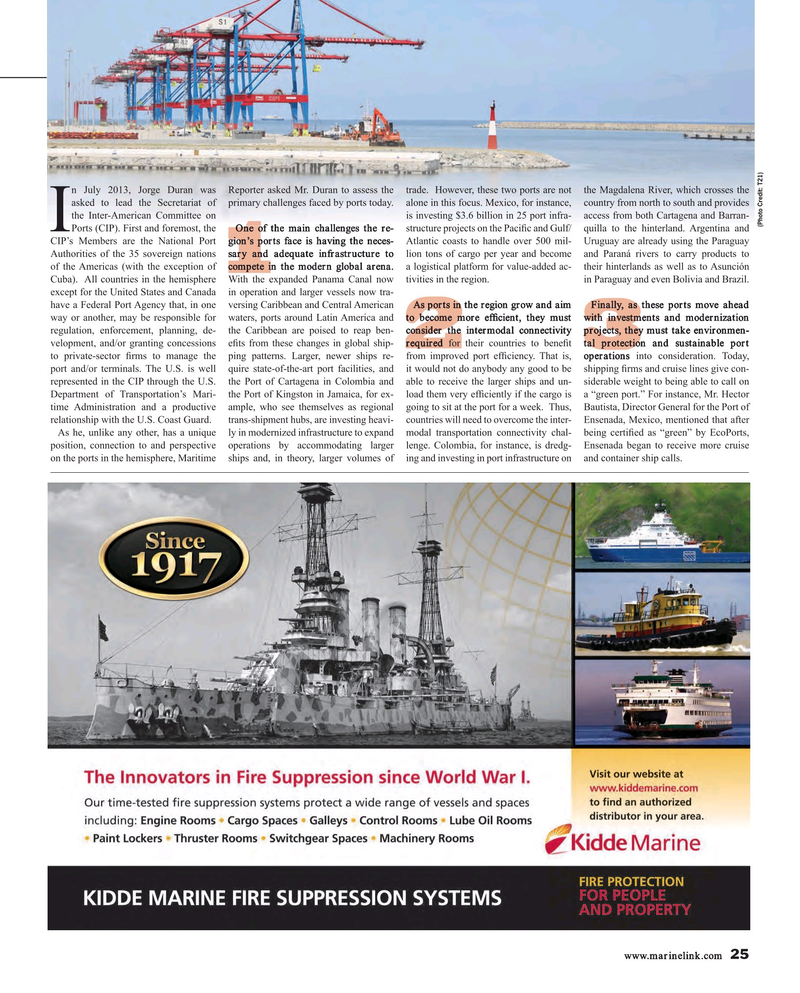
Page 25: of Maritime Reporter Magazine (October 2016)
Marine Design Annual
Read this page in Pdf, Flash or Html5 edition of October 2016 Maritime Reporter Magazine
n July 2013, Jorge Duran was Reporter asked Mr. Duran to assess the trade. However, these two ports are not the Magdalena River, which crosses the asked to lead the Secretariat of primary challenges faced by ports today. alone in this focus. Mexico, for instance, country from north to south and provides the Inter-American Committee on is investing $3.6 billion in 25 port infra- access from both Cartagena and Barran- (Photo Credit: T21)
IPorts (CIP). First and foremost, the One of the main challenges the re- structure projects on the Paci? c and Gulf/ quilla to the hinterland. Argentina and
CIP’s Members are the National Port gion’s ports face is having the neces- Atlantic coasts to handle over 500 mil- Uruguay are already using the Paraguay
Authorities of the 35 sovereign nations sary and adequate infrastructure to lion tons of cargo per year and become and Paraná rivers to carry products to of the Americas (with the exception of compete in the modern global arena. a logistical platform for value-added ac- their hinterlands as well as to Asunción 1
Cuba). All countries in the hemisphere With the expanded Panama Canal now tivities in the region. in Paraguay and even Bolivia and Brazil. except for the United States and Canada in operation and larger vessels now tra- have a Federal Port Agency that, in one versing Caribbean and Central American As ports in the region grow and aim Finally, as these ports move ahead way or another, may be responsible for waters, ports around Latin America and to become more ef? cient, they must with investments and modernization regulation, enforcement, planning, de- the Caribbean are poised to reap ben- consider the intermodal connectivity projects, they must take environmen- velopment, and/or granting concessions e? ts from these changes in global ship- required for their countries to bene? t tal protection and sustainable port 2 3 to private-sector ? rms to manage the ping patterns. Larger, newer ships re- from improved port ef? ciency. That is, operations into consideration. Today, port and/or terminals. The U.S. is well quire state-of-the-art port facilities, and it would not do anybody any good to be shipping ? rms and cruise lines give con- represented in the CIP through the U.S. the Port of Cartagena in Colombia and able to receive the larger ships and un- siderable weight to being able to call on
Department of Transportation’s Mari- the Port of Kingston in Jamaica, for ex- load them very ef? ciently if the cargo is a “green port.” For instance, Mr. Hector time Administration and a productive ample, who see themselves as regional going to sit at the port for a week. Thus, Bautista, Director General for the Port of relationship with the U.S. Coast Guard. trans-shipment hubs, are investing heavi- countries will need to overcome the inter- Ensenada, Mexico, mentioned that after
As he, unlike any other, has a unique ly in modernized infrastructure to expand modal transportation connectivity chal- being certi? ed as “green” by EcoPorts, position, connection to and perspective operations by accommodating larger lenge. Colombia, for instance, is dredg- Ensenada began to receive more cruise on the ports in the hemisphere, Maritime ships and, in theory, larger volumes of ing and investing in port infrastructure on and container ship calls. www.marinelink.com 25
MR #10 (18-25).indd 25 10/3/2016 3:29:45 PM

 24
24

 26
26
